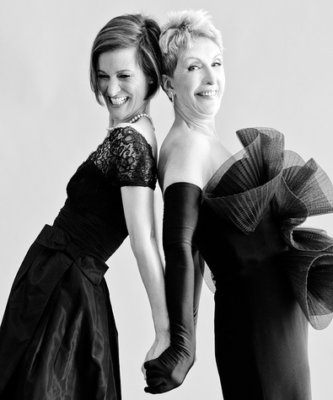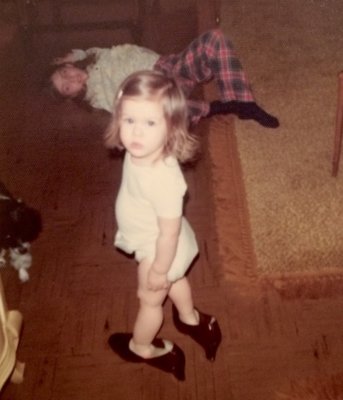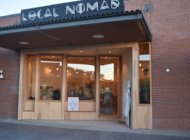|
Claudine Villardito, the mastermind behind Black Cat Vintage, an online retailer of the best vintage collection of clothing and accessories in Phoenix, launched her holiday pop-up store in Downtown Phoenix this December. I had the amazing opportunity to ask her some questions relevant for anyone trying to make in in the business of fashion, and to learn more about the cat-loving fashionista and her business.  Claudine and Her Mother 1. You’re now a world-renowned vintage expert who’s been featured in top publications including Vogue Italia. But what about the beginning? How did you become involved in the vintage fashion world and what prompted you to start Black Cat Vintage? Like any good daughter, I blame my mother for my addiction. We lived in Chicago, the birthplace of the great department store Marshall Field & Co. When my mom was a child, her mother worked in stationery and her best friend Louise was in Ladies’ Gloves, so—though she came from very modest circumstances—my mother was exposed to shopping early and honed it into an art form by adulthood. Her closets were filled with the most beautiful clothes I could fathom, and on Saturday mornings I would stand inside them while they hung. I grew so accustomed to—literally—being surrounded by clothes that when she brought me shopping with her, one of the first things I did was hide inside the centers of the racks so I could study the gowns without interruption. I did it so often that the shapes, fabrics and designers became second nature to me; fashion was like another language, and I learned it young enough to become fluent without knowing it.  Claudine raids her mother’s closet in 1976 In young adulthood, occasionally I would find vintage pieces that my hands recognized from my mother’s closet and I bought them without exception, no matter their size or condition; I felt compelled to “rescue” them from life in a thrift store or garage where they wouldn’t be appreciated. By the time my husband and I bought our home, I had rescued enough pieces that every closet was filled and I began to consider making a business of finding new homes for them. In 2000 I began studying fabric restoration and fashion history, and by 2005 I had learned couture hand sewing, beading, embroidery, sequining, millinery, fabric dying and pluming. I began selling on eBay in 2005 and by 2009 had my own e-commerce site where I gained an international following. Now I have over 3000 pieces, but every sale gives me the same rush as my very first one.
2. What characteristics about Black Cat Vintage make it stand out? How is it different from other local vintage stores? I don’t know of another vintage dealer in the world, much less the city, who goes to the lengths that I do for my clothes. Not only do I have some of the most collectible designers and important garments in fashion history, but I treat every piece like it was my mother’s since her clothes gave me the best education. Whenever possible, I meet with the original owners or their descendants to record oral histories for the garments; I gather any ephemera associated with the clothes, from original receipts of purchase to photographs of the owners in them to ads that featured them. Then I research the history of the piece itself so I know where it falls in the fashion timeline. Next, all my garments go through the same treatment as those housed in the Metropolitan Museum of Art: quarantine, deep freezing, inspection, cleaning and photographic documentation. If necessary, items that require attention are restored using vintage materials, tools and techniques. For example, a 1930s gown I restored was missing about half the crystals on its sleeves, so I determined the year it was made and found unsold backstock from a defunct Austrian crystal manufacturer from the same year; those are the crystals I used to restore the dress. Finally, once restored the clothes are housed in a purpose-built, sealed archive that is temperature, pressure and humidity-controlled. I have an app on my phone that alerts me if the temperature fluctuates a degree. Quite simply, my store is different because the clothes are my children, and I care how they’re treated and where they go. I want them to live their best life because they are extraordinary pieces of history, and when they’re gone a part of our collective history is gone. 3. Before now, Black Cat Vintage was exclusively online. Why did you choose to keep your business solely online for 11 years and what persuaded you to have a holiday pop-up shop now? What changed? In the beginning, Black Cat Vintage was an online boutique for reasons of overhead: it was much less expensive to operate a store without the expense of a bricks-and-mortar location. As my collection began to include very famous or rare inventory, a virtual presence made sense because it afforded me exposure to a worldwide clientele without the risk of damage posed by walk-in customers. However, since launching my own site in 2009 I also began offering private appointments for buyers who wished to see and fit garments in-person before buying, and provide a generous return policy for online clients who are unable to assess clothing personally.
My downtown Phoenix location was intended to be no different: it is located in the warehouse space of my husband’s business and built without general access for the purpose of online sales only. However, the space also includes a display window that faces First Avenue. Like the windows at Marshall Field & Co. in my hometown of Chicago, the displays are changed regularly and include full vignettes with scenery, backdrop and lighting. The displays drew so much attention that pedestrians began going in to neighboring businesses to ask how they could buy the clothes featured. So, after rearranging his showroom my husband wound up with some unused space he suggested I use for a holiday pop-up. I have lamented the lack of unique retail in downtown Phoenix for years, so I decided to become part of the solution even if only temporarily. Depending on response, the pop-up could become a permanent installation or be used as an exhibit space for museum pieces. 4. Your physical store is only 250 square feet. With such a limited space, how do you choose what pieces make the cut? I have divided my inventory into two groups: one consists of the ultra-exclusive, museum-quality pieces that Black Cat Vintage is famous for; the other is the more typical mid-century vintage clothing that might have been found in any woman’s closet. Both collections are restored and cared for the same way, but a selection of the less rare inventory is what I have chosen to display in the pop-up because I feel more comfortable with it being handled by the public. Still, I would argue it is 250 square feet of the best vintage clothing available in Phoenix…or anywhere. And if you really want to make an entrance, you can shop the vault by appointment.  5. What’s the best advice you have ever received? Do you have any advice for future fashion entrepreneurs? The best fashion advice I’ve ever received is to remember that true beauty comes from the inside: vintage or not, no garment can cover a shallow personality or a mean spirit. Your appearance isn’t a measure of your worth, but it is an indication of how you operate in society, what you value and your state of mind, so take care to communicate the message you intend. My advice for fashion entrepreneurs is the same as it would be for any entrepreneur: overnight success is a myth. A successful business is like a successful marriage, and the ones that last require hard work, flexibility, a willingness to endure despite setbacks and the ability to listen and learn. I would also remind anyone going into fashion to remember that the population is aging: by 2020, 35% of the US will be aged 50 and older, and by overlooking details that appeal to an older generation you lose one customer in three. So please, pretty please, use pockets, add linings and make some garments with sleeves for women who hate their arms. :) 6. Tell us about your favorite fashion era and icon! Such a hard question! Each time I think I’ve narrowed my favorite style to a certain decade I learn something or discover a piece from a different period that changes my mind. But all things considered, I would say the clothes of the 1920s are my ultimate favorites. The time was near enough to the Belle Epoque that ultra-luxe materials like silk thread, gold bouillon and real gemstones were still plentiful in fashion, and the clothes were so simply cut that they revealed real artistry in their construction, draping and finishing. As a lover of fine detail I also find the beadwork and embroidery on 1920s clothes inspiring; they exist as tangible proof that fashion is art, and nothing makes me happier than restoring a really complex bead or sequin dress from the Jazz Age. It feels like reviving a masterpiece.
Besides my mother, my fashion icon is Audrey Hepburn. Coltish, flat-chested and crooked-toothed, her allure was in her subtlety and sophistication. Despite finding stardom during the Marilyn Monroe era, her appeal was so potent that director Billy Wilder said, “This girl, single-handedly, may make bosoms a thing of the past.” Of course, being dressed by Hubert de Givenchy doesn’t hurt, but she had developed her sense of style before they met. Even when she was a struggling post-war stage actress, her friends remembered Audrey as having a single change of clothes, a beret and a dozen simple scarves…but somehow she always looked chic. The look she popularized was actually a departure from the prevalent style of the day, but she owned it so completely that women scrambled to emulate her. She had conviction, manners and grace, all of which are in short supply today but contribute as much to a person’s style as what’s hanging in their closet. All Photos Courtesy of Claudine Villardito Want to see more of the best fashion, beauty & culture in Phoenix? |
Around Arizona /
Couture in Your Closet /
Fashion /
Featured /
Influencer Interviews /
Interviews /
Phoenix /
December 28, 2016
Couture Conversations: Claudine Villardito of Black Cat Vintage
Previous Post
"Blown" away by Blo ScottsdaleNext Post
Exploring Barnone: A Craftsman CommunityYou might also like



















